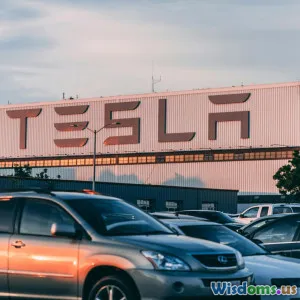
Innovations in Automotive Technology
8 min read Explore groundbreaking innovations in automotive technology reshaping transportation today, from electric vehicles to in-car AI. (0 Reviews)
Innovations in Automotive Technology
Introduction
In the rapidly evolving world of automotive technology, innovation is at the forefront of transforming how we interact with and understand vehicles. With the global push toward greener solutions and smarter connectivity, today's automotive landscape is a hub for groundbreaking advancements. From electric vehicles (EVs) to advanced safety features and artificial intelligence (AI), the innovations in automotive technology are not only enhancing the driving experience but also making cars safer, more efficient, and eco-friendly. Let’s dig deeper into some key innovations that are shaping the future of transportation.
The Rise of Electric Vehicles (EVs)
The automotive industry has witnessed a significant shift towards electric vehicles, driven by consumer demand for sustainable solutions and government regulations targeting emissions reductions. According to the International Energy Agency (IEA), there were over 10 million electric cars on the road in 2020, with projections suggesting that this number could climb to 145 million by 2030. Major manufacturers, such as Tesla, Nissan, Chevrolet, and more traditional automakers like Ford and GM, are heavily investing in electrification.
Charging Infrastructure Expansion
One critical factor in the adoption of EVs is the expansion of charging infrastructure. Governments and private companies are collaborating to create a robust network of charging stations, enabling curb-to-curb operation. The United States alone has seen a rise in the number of public charging stations from approximately 8,500 in 2017 to over 41,000 in 2021. The growth in charging infrastructure is key to addressing range anxiety, allowing drivers to recharge conveniently.
Autonomous Driving: Safety and Efficiency
The quest for fully autonomous vehicles is reshaping the way we think about road transport. Companies like Waymo, Tesla, and Uber are investing millions in developing reliable autonomous driving systems.
Levels of Autonomy
The Society of Automotive Engineers (SAE) has outlined six levels of driving automation, from Level 0 (no automation) to Level 5 (full automation). Notable players like Tesla's Full Self-Driving (FSD) feature operate around Level 2, where the vehicle takes control in certain situations, yet requires driver supervision.
Safety and Statistical Impact
Autonomous vehicles promise enormous potential for reducing traffic accidents, which are largely caused by human error. According to the National Highway Traffic Safety Administration (NHTSA), over 90% of accidents are tied to human mistakes. A feasibility study found that fully automated vehicles could reduce overall accident rates by as much as 90% in urban areas.
Smart Connectivity: The Internet of Things (IoT)
Automobiles are evolving from standalone entities to interconnected devices forming part of an IoT ecosystem. Modern vehicles can connect with smart infrastructure and other vehicles to provide comprehensive safety alerts which improve traffic flow and reduce accidents.
Vehicle-to-Everything (V2X) Communication
Vehicle-to-Everything (V2X) communication is a system that integrates vehicles to communicate with everything around them. It allows higher connectivity by enabling vehicles to interact with infrastructure, pedestrians, and other vehicles—providing real-time updates on traffic conditions. This technology could potentially save lives. A report by the National Academies of Sciences states V2X improvements could reduce traffic injuries by a staggering 81%.
Artificial Intelligence in Vehicles
Integrating AI within automotive technology is proving to be a game-changer in personalizing user experiences, enhancing safety, and even maintaining vehicles autonomously.
AI-Powered Driver Assistance Systems
ADAS (Advanced Driver Assistance Systems) utilize AI software to support driver-decisions through adaptive cruise control, lane-keeping assistance, and emergency braking systems. These systems analyze sensor data in real time to enhance driving safety and enjoyment.
Predictive Maintenance
AI is also revolutionizing how car manufacturers and service technicians approach vehicle maintenance. Predictive maintenance, powered by data analytics, helps forecast equipment failures before they happen, thereby reducing costs and improving safety. IoT sensors can monitor various engine parameters, alerting the driver and the manufacturers about potential issues, improving vehicle longevity.
Sustainability and Recycling Innovations
Automobiles have to evolve not only in performance but also in how they affect the planet. Recent developments are focusing on sustainability and recycling.
Eco-friendly Materials
Manufacturers are beginning to incorporate sustainable materials into vehicle construction. BMW’s i3 electric vehicle, for example, uses carbon fiber reinforced plastic that is also recyclable.
End-of-Life Vehicle Solutions
Innovations in recycling also extend to end-of-life vehicles. Automakers like Volkswagen are actively engaged in circular economy initiatives where old cars and components are repurposed. For instance, the steel from decommissioned vehicles can be recycled and used to build new ones, lowering the overall carbon footprint.
Future Trends to Watch
The automotive industry will undoubtedly continue to flourish with avant-garde technological advancements that are not flashy but play critical roles in enhancing functionality, safety, and sustainability. Innovators in the space are continuously exploring concepts such as flying cars, more robust energy storage solutions, and even further integration of artificial intelligence that could facilitate entirely new transportation models.
Embracing 5G Technology
5G technology is expected to revolutionize vehicle connectivity by enabling faster data transfer between vehicles and surroundings, enhancing safety, infotainment systems, and diagnostics.
Mobility as a Service (MaaS)
MaaS is a paradigm shift in public transportation models, integrating various modes of transportation into a single accessible platform. The future may see cars morphing into shared enterprises where car ownership becomes less critical.
Conclusion
Innovations in automotive technology are permeating our lives through electric vehicles, autonomous driving capabilities, smart connectivity, and AI never before imagined. As we trace advancements from the last few decades, it’s evident that the future of transportation holds immense promise. The industry's trajectory suggests this revolution will not merely change how we operate vehicles but how we conceive mobility as a whole. Continuous investment in R&D and collaboration among stakeholders—from manufacturers to tech giants—will ensure that as these innovations develop, they will ultimately contribute to safer, smarter, and greener roads ahead.
Rate the Post
User Reviews
Popular Posts


















